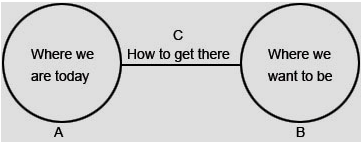New
Strategic and tactical planning
One method for taking advantage of both the common and diverse interests of the membership of a local union is to approach bargaining as one aspect of a broader process of strategic planning. Strategic planning is a proactive and dynamic process through which an organization strives to mobilize its resources in a purposeful way to achieve its clearly identified goals. Although there are many strategic planning models, the critical elements of a strategic planning process are outlined below.

In short, solving for C appears easy. It often is not. Once you have determined both A and B, C becomes the only variable in flux.
- Identification of long-term goals
Point B on the diagram, above, illustrates the long-term goals of an organization. If an organization has a clearly defined mission, it is important to look to the future to determine major goals that need to be accomplished in three, five, or more years into the future. If you do not know what your organizations goals are, you must start here. Without goals, organizations react and drift with the issues of the day in a reactive manner, instead of a proactive manner. Goals are the major accomplishments the organization needs to achieve to fulfill its mission. They should be realistic, dynamic, and prospective. - Identification of measurable steps to accomplish goals
Short-term goals or objectives are the measurable steps needed to reach each of the goals of the organization. The objectives and short-term goals of the organization are illustrated by line C on the above diagram. Objectives should be specific, reasonable, and measurable. One of the easiest ways to adversely affect the planning process is to define goals and objectives that are beyond the realistic reach of the organization.

- Assessment of organizational strengths and weaknesses
The heart of the planning process is an honest assessment of the organization's strengths and weaknesses and the external pressures that will make fulfillment of the mission either easier or more difficult. Failure to be totally honest with yourselves or wearing rose colored glasses and remaining overly optimistic while doing the assessment leads to devastating or unproductive outcomes later. Strategic planning demands a critical internal assessment of the assets of the organization as well as internal factors that will be expected to impede accomplishment of goals. In the bargaining process, levels of membership support, the relationship between the local and the international, and the experience of negotiators and other officers are all examples of internal resources that need evaluation. - Evaluation of external opportunities and threats
Just as a critical internal assessment is important in the planning process, it is essential to understand the external forces that will assist or hinder the organization's progress toward accomplishing goals and objectives. More often than not, the bargaining process is more influenced by what happens away from the table then at the bargaining table. Influencers include, but are not limited to, the economy, the company, other unions, the media, and the community. - Establishing realistic expectations
Goals and objectives of the union in the planning process should be realistic. With an honest assessment of the internal resources and external forces that affect union strategy, the union should be able to identify concrete accomplishments that are within reach, as well as matters that would be nice but are probably unachievable. To maintain and build membership support, it is best to be able to demonstrate a capacity to reach the attainable rather than to fail to achieve the unrealistic dreams. - Setting priorities
Establishing expectations and setting priorities among those expectations are examples of the direct relationship between a strategic planning process and the bargaining agenda of the local union. In the context of bargaining, the expectations and the priorities among those expectations are the demands of the union in the bargaining process and the bargaining agenda. - Evaluating the results
The aspect of any local union planning process that is most often overlooked is evaluation, not only at the end, but ongoing during the bargaining process. When the bargaining is done, it is also important to step back and reassess the process from the planning, through the bargaining to the implementation of the newly bargained agreement. Where the goals met? If so, why? If not, why not? What can be done in the future to accomplish those goals that were not met this time? The planning process is dynamic, so that as soon as any objective is met or delayed, it is important to reassess the plan of the organization. A good final step is to write a note to the next bargaining time with lessons learned and possible starting strategies for their consideration when it is time to return to the bargaining table.